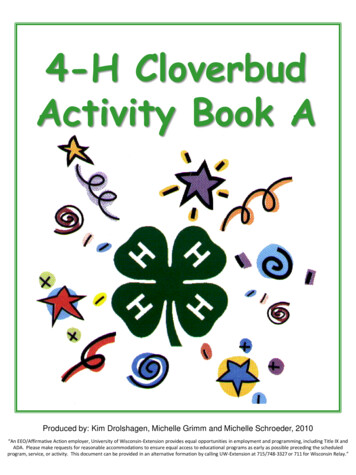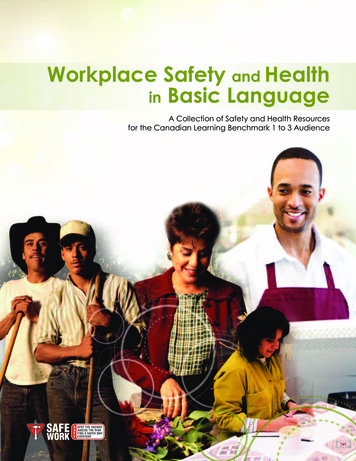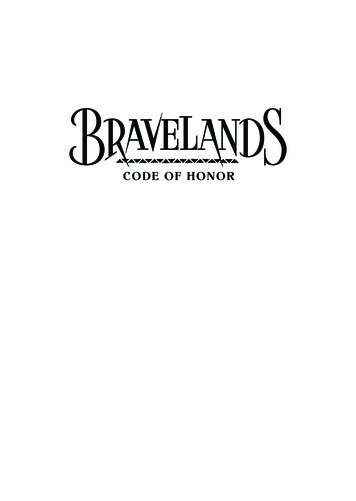
Transcription
4-H CloverbudActivity Book AProduced by: Kim Drolshagen, Michelle Grimm and Michelle Schroeder, 2010“An EEO/Affirmative Action employer, University of Wisconsin-Extension provides equal opportunities in employment and programming, including Title IX andADA. Please make requests for reasonable accommodations to ensure equal access to educational programs as early as possible preceding the scheduledprogram, service, or activity. This document can be provided in an alternative formation by calling UW-Extension at 715/748-3327 or 711 for Wisconsin Relay.”
My 4-H Clubp. 3 A Little Bit About Mep. 4 About 4-Hp. 5 4-H Pledgep. 6 My Club and County Activities & Eventsp. 7 Create-A-Critterp. 8 Ant ANTatomyp. 9 Create a Habitatp. 10 Let’s Make Sidewalk Chalkp. 11 Puppet Creationsp. 12 Sand Paintingp. 13 Beanbag Socksp. 14 Graham Cracker Scramp. 15 Kitchen Safetyp. 16 First Aidp. 17 Let’s Learn About Sound!p. 18 Make a Constellationp. 19 Examples of Constellationsp. 20 Sink or Float?P. 21 All About Leavesp. 22 Leaf Identification Guidep. 23 Let’s Grow Vegetables!P. 24 Measuring Rainp. 25 Referencesp. 262
My 4-H ClubMy Name:4-H Club Name:4-H Leader’s Name:Phone Number:Other Club Members:4-H Youth Development Agent’s Name:Phone Number:3
PlaceYourPictureHereName:Age:My Family members:My favorite activities:4
4-H Club EmblemThe four leaf clover with theletter “H” on each leaf, whichstands for head, heart, handsand health. The colors of theemblem are green and white.4-H Motto“TO MAKE THE BEST BETTER”This motto challenges everyoneinvolved in 4-H to do the verybest job they can.4-H Slogan“LEARN BY DOING”5
I pledge:4-H PledgeMy Head to Clearer Thinking (Right hand points to forehead)My Heart to Greater Loyalty (Right hand over heart)My Hands to Larger Service (Arms slightly bent, palms up)And My Health to Better Living for My Club,My Community, My Country and My World (Arms at side)6
My Club and CountyActivities and EventsActivities and events I was part of:EventDate7
Animal SciencesAnimal LifeCreate – a - CritterMake up a brand new critter. Construct your critter by using someof the materials listed below, and then draw a picture of yourcreation. Decide the details by completing the sentences below.Draw a picture of your critter here.My critter’s name is .It lives in the .It eats .It moves by .It is special because it .Materials: straws, toothpicks, paper,paper plates, modeling clay, crayons, anyother items you may have8
Ant ANTatomyAnimal SciencesAnimal LifeCreate your own ANT!Ants are a type of insect that have six legs, two antennae and threebody sections. The three body sections are the head, thorax andabdomen.Ants live in colonies made up of queens, males and workers. They areamazing creatures that come in different colors, with black being themost common. Ants can carry up to 27 times their body weight!Where do you see ants?What color ants have you seen before?How many antennae do ants have?Can you name the three body sections of an ant?How many legs do ants have?Time to make your ant!Materials: three large marshmallows, 4 large pipe cleaners cut in half,2 toothpicks, scissors and markers.Procedure:1. Use the three large marshmallows as the body sections andconnect them using toothpicks.2. Cut 4 large pipe cleaners in half to make 8 small pipe cleaners.Use 6 for the legs and insert 2 for the antennae.93. Decorate your ant using markers.
Create a HabitatAnimal SciencesAnimal LifeDraw a picture of your habitat here.Choose an animal and create its habitat!For this activity, choose any animal and look up its habitat. Ananimal’s habitat is the area in which it lives. For example, yourhabitat is your house because it is where you live.You can make your habitat out of anything you would like. Afew suggestions are: shoebox, construction paper, glue,markers, grass and twigs.My animal is a . It lives.It eats .10
Expressive ArtsLet’s Make Sidewalk ChalkPlace a picture of your artwork here.Materials:2 cups water2 cups Plaster of Paris2 Tablespoons Tempera Paint (wet or dry)Toilet paper tubes with duct tape over one endCookie sheet lined with aluminum foil or waxedpaperProcedure:1. Combine and stir together all ingredients, and let standfor a few minutes.2. Place prepared toilet paper tubes on cookie sheet linedwith aluminum foil or waxed paper.3. Pour mixture into holders, let stand until semi-firm.4. Remove holders and let dry completely.5. Ready to use in 1 ½ hours.6. Now use your sidewalk chalk to draw a picture outside!CAUTION: DO NOT POUR PLASTER DOWN THE DRAIN11AND MAKE SURE ADULTS SUPERVISE THE MIXING!
Expressive ArtsPuppet CreationsLet’s create a puppet and perform a puppet show!Materials:Procedure:Lunch bagMarkersGoogly EyesYarnGluePipe CleanersOther Craft SuppliesUsing your supplies create puppets and performa show for your friends and family!Draw a picture of your puppets here.12
Expressive ArtsSand PaintingDraw a picture of your artwork here.Let’s create a picture using sand!Materials:Dry Sand (in paper cups)PencilCrayonsWhite GluePaper or CardboardNewspapersProcedure:1. Use a pencil to draw a picture design lightly on paper.2. Apply a bead of glue to the pencil lines.3. Sprinkle sand gently over the wet glue.4. Tile the paper so the extra sand falls off the paper ontothe newspaper.5. Let dry.6. Use crayons to add details or color to the sand painting.13
Family, Home and HealthBeanbag SocksPractice some sewing skills while making abeanbag sock!Materials: Unmatched SockDried BeansLarge Darning NeedleColorful YarnScissorsMarkersProcedure:1. Collect the materials needed.2. Fill sock with dried beans, leaving room to sew the top ofthe sock.3. To finish the sock – close to the beans stitch the topclosed using the colorful yarn and darning needle.4. Use markers to decorate the sock.See if you can come up with a fun game to playwith your new beanbag sock!14
Family, Home and HealthGraham Cracker ScramLet’s Make a Delicious and Nutritious Snack!Make sure to ask an adult for help!Ingredients:Equipment:Graham CrackersPeanut ButterBananas, slicedLow-fat milkPlastic KnifePaper PlatesPlastic Glasses, for milkNapkinsProcedure:1. Before making the snack, make sure to wash your handswith soap and warm water.2. Use the plastic knife to slice the bananas.3. Take a half of a graham cracker and spread peanutbutter on it and then top the peanut butter with slicedbananas. Add the other half of the graham cracker tothe top and enjoy with a glass of low-fat milk.This snack is made with everyday foods that are healthy forus, like peanut butter and fruit. Can you think of any othereveryday foods you could use to make a similar snack?15Recipe adapted from Kitchen Science for Kids, Cornell University Cooperative Extension,1995 and Kangaroo Jump 5: Power Up the Day, Michigan State University Extension
Family, Home and HealthKitchen SafetyCircle all of the unsafe things in this picture.Do you have any of these habits in your kitchen?List the things you will change about your own safety habits.16
First AidFamily, Home and HealthExamine the items you find in a first aid kit, and write whatthey are used for.BandagesSterile GauzeAdhesive TapeAntiseptic WipesAntibiotic OintmentSterile GlovesNow, let’s make a First Aid Kit!Ask an adult to help gather the materials listed above. Find an old coffee can,plastic zip-lock bag, old lunch box, plastic container or anything that can helphold your first aid supplies. Keep your first aid kit in a safe place you can easilyget to.17
ScienceLet’s Learn About Sound!Sound is a vibration moving through air, water, or some othermaterial. Our ear collects these vibrations and turns theminto a signal which is sent to our brain.Let’s Make Some Noise!Build a KazooMaterials:Toilet Paper TubeWaxed PaperRubber BandCrayonsScissorsProcedure:1. Cut a square of waxed paper to cover the toilet papertube.2. Secure the waxed paper to the end of the toilet papertube using a rubber band.3. Decorate your kazoo using crayons.4. Practice humming without your kazoo.5. Now try to hum using your kazoo.Does your humming noise sound different when your use akazoo? What is vibrating on your kazoo?Do you think that changing the length of the kazoo will change18the sound? . Try it!
ScienceMake a ConstellationConstellations are pictures made up of stars. They wereoften named after items people were familiar with like animalsor mythical people.Constructing a ConstellationMaterials:8 ½ “ x 11” White Paper8 ½ “ x 11” Black Construction PaperPencilMetal PinStars CutoutsScissorsGlueWhite CrayonProcedure:1. Draw a picture of your constellation on the white paper.You may draw a constellation from one listed on thenext page or create your own.2. Line up your white and black papers. Using the metalpin, poke a hole through every corner of your design.3. Cut out stars and glue one on every pin hole.4. Connect the stars using a white crayon.Star Cutout Pattern19Adapted from: Mini 4-H Space. By: Roylene Laswell. Purdue University Extension Service.
ScienceALL YEARExamples of ig DipperHerculesLeo20
ScienceSink or Float?Does it float? Try different objects and record if they sinkor float.Materials:SpongePaper ClipToothpickMarblePlastic SpoonPennyPlastic StrawCrayonPlastic Dishpan or Bucket, filled with waterTowelPiece of PaperPencilProcedure:1. Divide your piece of paper into two. On one side writeFLOAT and on the other write SINK.2. Make predictions of which objects you think will sinkand which will float.3. Time for testing! With the container filled with water,place each object in it one at a time and recordwhether the object floats or sinks.Which items did you guess correctly?Why do you think some items sink and some float?.21
Natural ResourcesAll About LeavesLet’s collect, identify and preserve leaves!Materials:Roll of Wax PaperFresh Fall LeavesPlain, Scrap PaperIron for Pressing9 x 12” Construction PaperStaplerPermanent Marker for Labeling LeavesTree Field GuideProcedure:1. Take a nature walk and collect some fall leaves.2. Using a tree field guide identify each leaf.3. Press the leaves by layering them between plain paper. Repeatlayers until all leaves are placed. Make a paper-and-leafsandwich and place a heavy book on top. After a couple ofdays carefully remove the pressed leaves.4. Cut a piece of waxed paper 2 feet long. Lay out the pressedleaves on the waxed paper in any pattern, but make sure toleave a 1 inch border on the long sides and a 2 inch border ateach end.5. Have an adult help you lay the waxed paper design on an ironingboard. Place another layer of waxed paper on top of yourdesign. Working gently and quickly use the iron to press thewax layers together. You will only need a second or two forthe wax to adhere.6. Use the construction paper to make a border around yourwaxed paper and adhere it using a stapler.7. Have an adult help hang your artwork in a window!22
Natural ResourcesLeaf Identification oreBasswoodCottonwoodThese are just a few types of leaves, please use a TreeIdentification Guide for more information.23
Natural ResourcesLet’s Grow Vegetables!Let’s identify seeds using a handy seed chart.Materials:White Paper PlateRulerGlueMarkers8 Kinds of Seeds (Example: Bean, Pea, Spinach,Corn, Radish, and Cucumber)Procedure:1. Divide the paper plate into eighths, like a pie. First divide theplate in half, then in fourths, followed by eighths. Draw linesusing a marker and a ruler.2. In each segment, glue a seed, label it, and draw a picture ofthe vegetable.It’s now time to plant some seeds!Materials:Seeds (leftover from the handy seed chart)Potting SoilPaper Egg CartonWaterProcedure:1. Remove the lid from the egg carton and fill each section about¾ full with potting soil.2. Place the seeds in the soil according to the package directions.3. Place the egg carton in a location of natural light and waterthe seeds regularly.4. Watch your garden grow! As the seedlings get larger,transplant them into your garden or larger pots by cutting theegg carton segment and planting the whole part in the ground.24
Natural ResourcesMeasuring RainRain is a type of precipitation that is often measured using arain gauge. Let’s make a rain gauge!Materials:Glass JarPermanent MarkerRulerStickersPaintProcedure:1. Place a ruler along a glass jar and mark every ½ inchusing a permanent marker. Make sure to label themarks.2. Decorate your rain gauge using stickers or paintshowever you would like.3. Place rain gauge outside in a flat open area.Make sure to empty the jar aftereach rain.Observations:How much rain was in your rain gaugeafter a storm?What other types of precipitation arethere?25
References http://www.education.com/activity/ A great website for activity ideas. 4-H Mini Space. 4-H-911-6. By: Roylene Laswell. PurdueUniversity Extension H/4H-911-6.pdf Cloverbuds Activities Packet. By: Richard Moreland andLori K. Hutchins. University of Minnesota ExtensionService. Cloverbud Program Manual. Montana 4-H.http://www.montana4h.org/#project:53. Environmental Science/Plants & Animals Activity Guide Science and Technology Activity Guide26
4-H Members,We have compiled new project material for 4-H Cloverbuds. The material will nowbe on a three year rotation, with 4-H Activity Book A, B, and C. Each year, allCloverbuds will be doing projects out of the same activity book.The Cloverbud Activity Book is designed to introduce Cloverbuds to many different4-H areas. The new booklets provide activities in Animal Sciences/Animal Life,Expressive Arts, Family, Home, and Health, Science, and Natural Resources.Please give feedback about the new 4-H Cloverbud Activity Book and return it tothe UW Extension Office.Sincerely,Michelle GrimmTaylor County 4-H Youth Development AgentUW Extension Office925 Donald Street, Room 103Medford, WI 54451(715) 748-3327(715) 748-9772 (fax)711 (Wisconsin --------------------------------Comments about the new 4-H Cloverbud Activity Book:
Now, let’s make a First Aid Kit! Ask an adult to help gather the materials listed above. Find an old coffee can, plastic zip-lock bag, old lunch box, plastic container or anything that can help hold your first aid suppl









